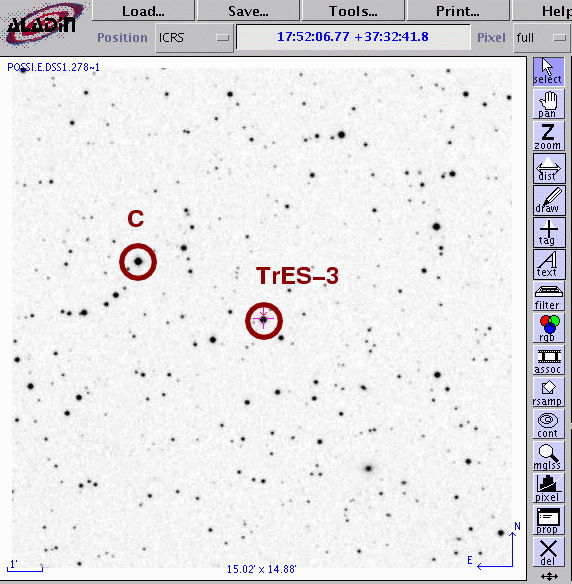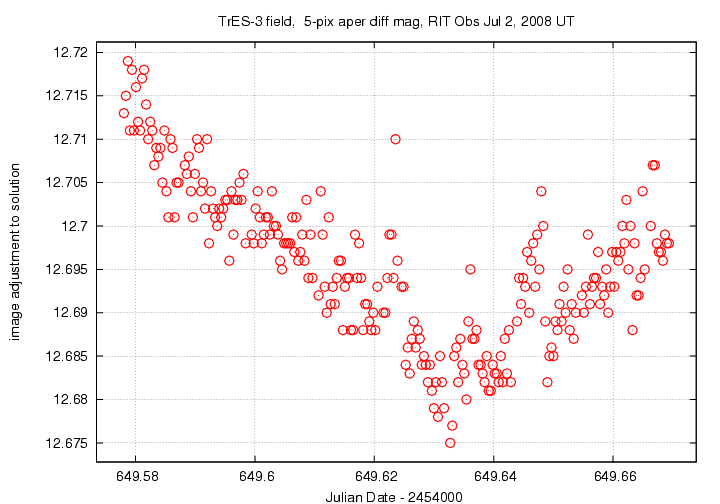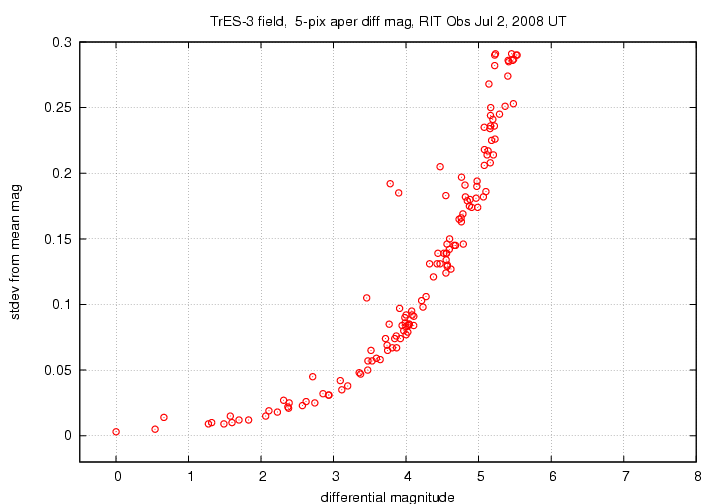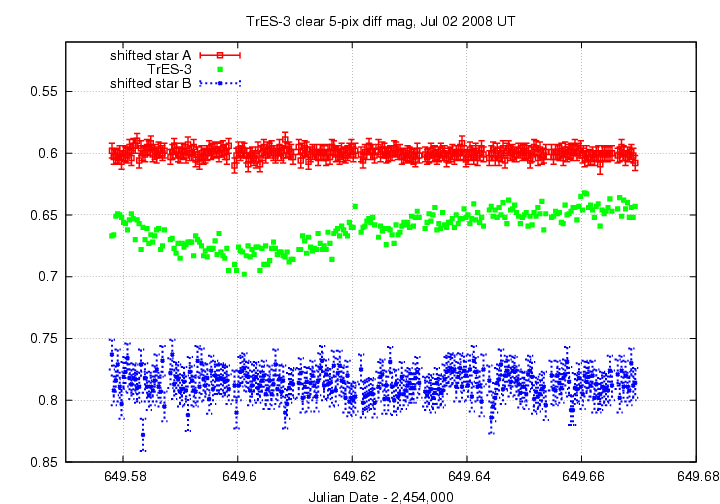
On the night of Jul 01/02, 2008 EDT, a local high school student and I used the RIT Observatory's 12-inch Meade telescope and SBIG ST8 CCD camera to monitor the extrasolar planetary system TrES-3. This star is orbited by a large planet, and occasionally the planet passes in front of the star and blocks some of its light. For more information about it, read
A student at the local Greece Athena High School, Derek Langdon, is doing an independent study project involving extrasolar planets. He has been studying the literature and looking up good dates for transits we can observe from Rochester. This is the first time we've had good weather on a night when a known extrasolar planet has been transiting.
The plan:
Notes from the night
This is a chart of the target's field.

I measured the instrumental magnitude of all stars in the field with aperture photometry, using a radius of 3 pixels = 9.3 arcseconds and sky defined by an annulus around each star. Following the procedures outlined by Kent Honeycutt's article on inhomogeneous ensemble photometry, I used all stars available in each image to define a reference frame, and measured each star against this frame.
Here's an estimate of the zero-point of the instrumental magnitudes as a function of time during my run. If the night is clear, this graph ought to be a horizontal line (or perhaps gently curved due to changes in airmass). The variations are small, less than 0.06 mag, which means the night was pretty clear.

Below is a graph of the scatter in differential magnitude versus magnitude in the ensemble solution.

The brightest star in the ensemble is the one labelled "C" above; it has a formal scatter of 0.003 mag from one measurement to the next. The target is the star near differential magnitude 0.66; note that its scatter from its mean value is larger than that of stars of similar brightness. That's a sign that it is varying.
Light curves for selected stars (TrES-3 and stars A and B) in the field are shown below. I've shifted the other stars to make them appear close to the magnitude of the target. TrES-3, shown by light green crosses, shows a clear dip. Just looking by eye, I estimate that the ingress was at or before the start of the observations; the egress is a little tricky, since there appears to be a "precursor" rise at about 649.625, followed by a final rise which ends around 649.64. However, the rise is gradual, which makes it difficult to measure accurately.

The Transitsearch.org web site has an ephemeris for this object:
Begin Transit Window PREDICTED CENTRAL TRANSIT End Transit Window
All Times UT
HJD Year M D H M HJD Year M D H M HJD Year M D H M
---------------------------------------------------------------------------------------
2454649.57 2008 7 2 1 36 2454649.61 2008 7 2 2 34 2454649.65 2008 7 2 3 33
The predicted time of ingress corresponds to 649.567, which is just before the start of our measurements. The predicted time of egress corresponds to 649.648, a bit later than the later egress estimate from my eyeball inspection of the light curve.
I've made a table of the measurements themselves, with three different flavors of time. The differential magnitudes from the ensemble solution have been left as is, so that the brightest star (the one labelled "C" in the chart) has value 0.00.
Here's the start of the table.
# Measurements of TrES-3 made at RIT Obs, Jul 2, 2008 UT. # Each exposure 20 seconds long with no filter; # Tabulated times are midexposure (FITS header time - half exposure length) # and accurate only to +/- 1 second (??). # 'mag' is a differential magnitude based on ensemble photometry # using a circular aperture of radius 9.3 arcseconds. # # UT day JD-2,450,000 HJD-2,450,000 mag uncert Jul02.57804 2454649.57804 2454649.57651 0.667 0.006 Jul02.57838 2454649.57838 2454649.57685 0.666 0.006 Jul02.57872 2454649.57872 2454649.57719 0.651 0.006
Last modified 7/02/2008 by MWR.